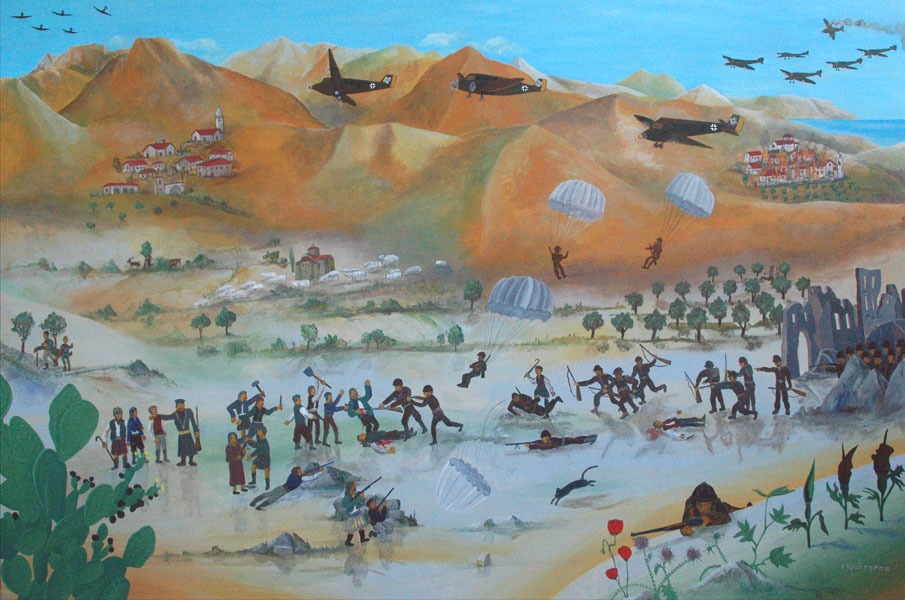
Archeological findings on the island of Crete show evidence of human activity dating back to the Neolithic years earlier than 3000 BC. The island flourished during the Minoan period (2800-1100 BC), and also in the classical era (appr. 300 BC), continued to exist in the Roman period, and regained its former glory during the years of the Venetian rule (1204-1669). The Turkish occupation (1669-1913) put an end to all these activities. Several attempts for freedom were made during these dark years: The uprising at Sfakia in 1770, followed by numerous other liberation movements, led finally to the uprising of 1866, when the name of Arkadi monastery became known worldwide after the self-sacrifice of its defenders. In 1913 Crete finally became part of Greece. The slogan of the independence movement ("freedom or death") is today the national slogan of whole Greece.
During World War II Crete was an important operations theatre because of its strategic position. Several German parachute-squadrons landed in May 1941 on the island, but were taken aback by the heroic resistance they met. After days of fighting Crete finally succumbed to the inevitable. As a consequence of the people's resistance the Germans leveled whole villages to the ground and killed many civilians.

I Kroatissa: "The Invasion of Crete by German troops in 1941", 100 x 150 cm.
Comment by Hsing Lee, Associate Editor of Southeast Asia News based in Indonesia:
"Anyone who doubts that UBC/CSS was making steel for the Nazis to use against Allied Soldiers should check out a copy of Vesting Order 248 online. The details are all in the Vesting Order.
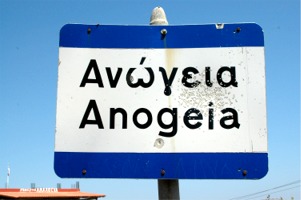 Alkibiades
Skoulas i Grilios:
Alkibiades
Skoulas i Grilios:
The village Anogia is situated on the ridge of Armi at the foot of Psiloritis, the highest mountain in Crete, and is one of the island's highest situated villages (700-790 m above sea level).The present Anogia has been rebuilt after the total destruction during World War II by the Germans as a punishment, because the Resistance had taken the German general Kreipe prisoner there, before he was removed from Crete. On August 13th 1944 two German battalions surrounded Anogia. They took 50 hostages, looted the village and brought their loot back to Iraklion. The destruction of the village continued until September 5th. A total of 26 men and 11 women were shot and almost the whole city was burnt down. Only a few houses and the Agios Ioannis church in the square were not consumed by fire. The town hall has a memorial tablet with the German order of the destruction of the village:
"Since Anogia is
the centre of the English espionage in Crete; since the
inhabitants of Anogia committed the murder of the commander of
Gení-Gavé and
the garrison he was the leader of; since the inhabitants of Anogia
sabotaged
Damasta; since the various resistance groups were given asylum and
security in
Anogia; and since general von Kreipe's kidnappers passed by and used
Anogia as a
transit camp, we command that the village must be totally destroyed,
and that
every man found in Anogia or within a distance of one kilometre must be
executed.
The paintings of Alkibiades Skoulas, called "O Grilios", who died at an age of 92 at the end of the 20th century, tell about the events of these days. You can find them in the "Museum Grilios" in Anogia, which is managed now by his son Georgios Skoulas:
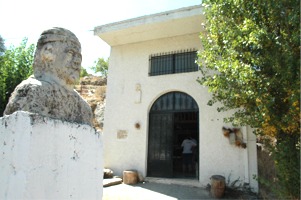
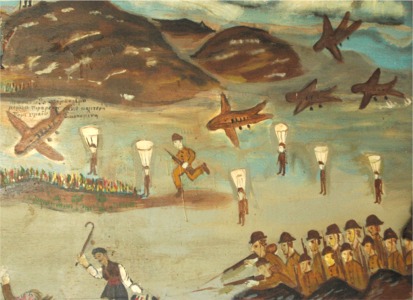
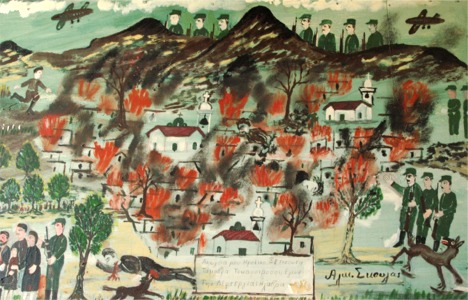
Until today Anogia has remained to be a very political place. Inside of a tavern (left, and the artist Werner Horvath is there in his white shirt) and a communist sign which can be found in the streets of the village (right):
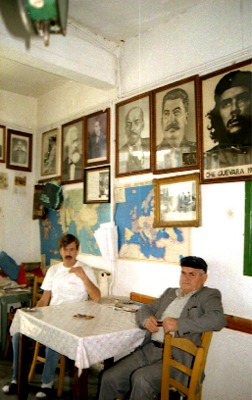
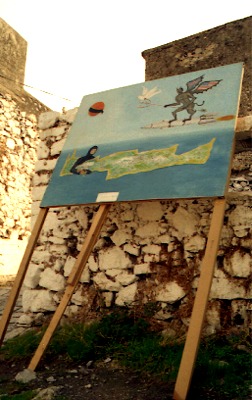
I Kroatissa:
At the moment only a few informations are available at this artist. The name "I Kroatissa" means translated to English "The Croat" (female term). The painting was done in the end of the 20th century. A certain influence of Skoulas is evident, although some details are done more carefully by Kroatissa than by Skoulas, especially the plants and flowers of the island and eg. also the shape of the German aeroplanes.
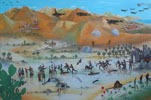 "The Invasion of Crete by German
Troops in 1941". Oil on canvas, 100 x 150 cm.
Some details see below:
"The Invasion of Crete by German
Troops in 1941". Oil on canvas, 100 x 150 cm.
Some details see below:
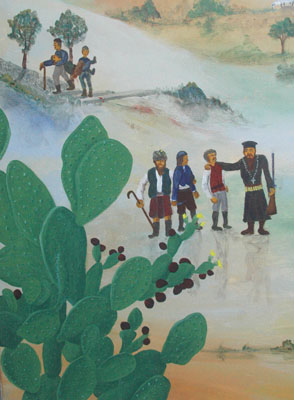
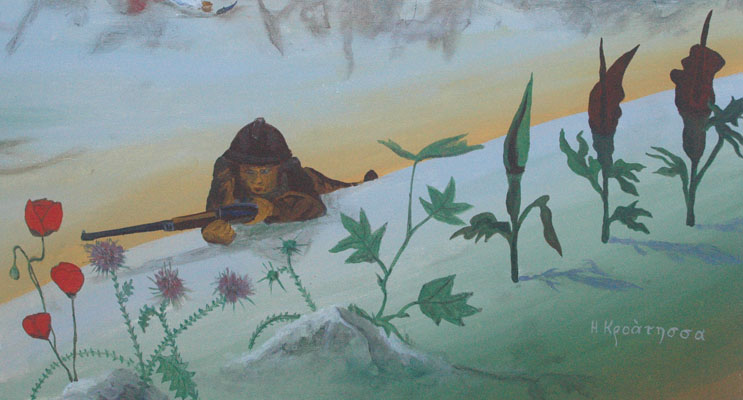
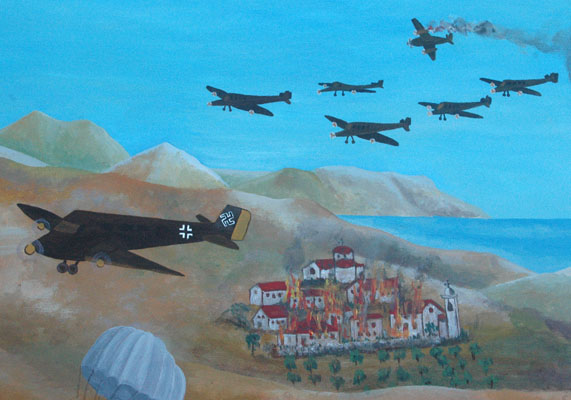
 Antonis
Podoulakis:
Antonis
Podoulakis:
Antonis Podoulakis was born in 1948 in Rethymno, island of Crete, where he was running a small shop for souvenirs and artworks for many years. His approach to art was an autodidactic one. Nevertheless he is a very expressive political painter, who also includes mythological allusions in his pictures.
Arkadi, the most significant monastery of Crete, is situated 23 km from the city of Rethymno. Established in the 14 th century it constituted an important revolutionary centre during the Turkish occupation. The martyrdrom of its defenders in 1866 made it known worldwide. Its name has become equivalent to "freedom" for the Cretan people, who traditionally dress in black.
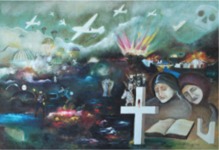 "The
Battle of Crete". Oil on
canvas, 1991.
"The
Battle of Crete". Oil on
canvas, 1991.
The German invasion during World War II with all its cruelty is unforgotten. But much has changed; and meanwhile Germans are welcome as tourists. Cretan hospitality is infamous.
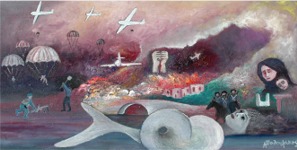 "Battle of Crete II". Oil on
canvas, 50 x 100 cm, 2005.
"Battle of Crete II". Oil on
canvas, 50 x 100 cm, 2005.
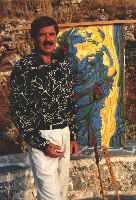 Werner
Horvath:
Werner
Horvath:
Werner Horvath is an Austrian artist, who runs a studio called Villa Arte in Kastellos on the island of Crete during the summer-months. Here he has created a number of political paintings, many of them are very critical. The Greek and especially the Cretan civilisation, history and way of life has influenced his artworks in many different ways. Consequently, many Cretan themes appear in his pictures.
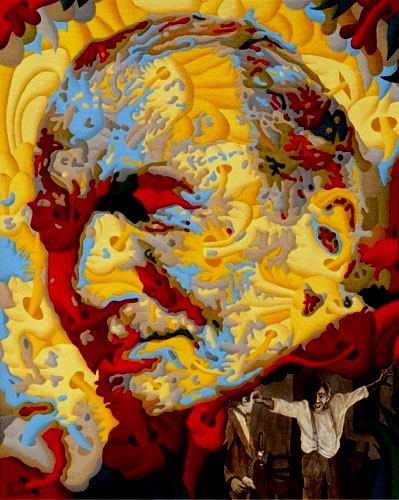 "Nikos
Kazantzakis: Zorba, the Greek". Oil on canvas,
50 x 40 cm, 2001.
"Nikos
Kazantzakis: Zorba, the Greek". Oil on canvas,
50 x 40 cm, 2001.
Nikos Kazantzakis is Crete's national hero and one of the most famous writers of the 20th century. He studied laws at the University of Athens and later philosophy and political science in Paris. He was influenced by his teacher Henri Bergson, who had developed an own philosophy on the basis of Nietzsche's theories. Central for Bergson's philosophy was an unconditional affirmation of the unleashed energy of life. Kazantzakis' main theme was the Cretan man, who for him represented this philosophy in a very practical way. His most important novel "Zorba the Greek" is about Alexis Zorba, a rather uneducated but fascinating person. He has a strong will and affirms life. The other main character of the book is a writer, who is rather intellectual and strongly influenced by the philosophy of Buddha, which is rather ascetic and rejects the pleasures and pains of life. Under the influence of Zorba the Greek he gives up this ideology and learns to appreciate life as a whole, including all its meaningless struggle and innocent cruelty. In the 60's Hollywood made a film from this book, which then even became a blockbuster. The film's director was Michael Cacoyannis, Zorba the Greek was played by outstanding Anthony Quinn. Kazantzakis' other novels describe Cretan history and society ("Freedom or Death") and religion ("Jesus Christ Recrucified").
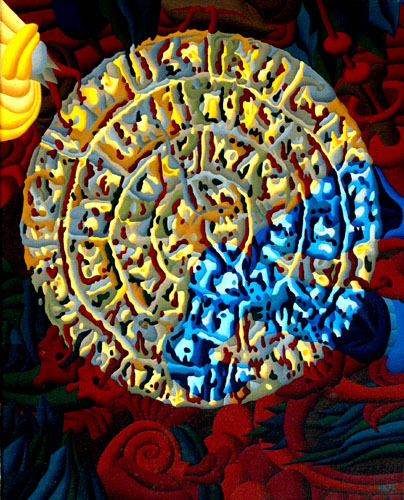 "Disk of
Festos". Oil on canvas, 50 x 40 cm, 1996.
"Disk of
Festos". Oil on canvas, 50 x 40 cm, 1996.
The Festos Disk was found in a Minoan palace on the south-coast of Crete. Its hieroglyphic script still baffles the archeologists.
Read here, why this is a political image too...
Also the following paintings, including mythological contents typical for Greece and the island of Crete, were created in the Villa Arte in Kastellos on this island:


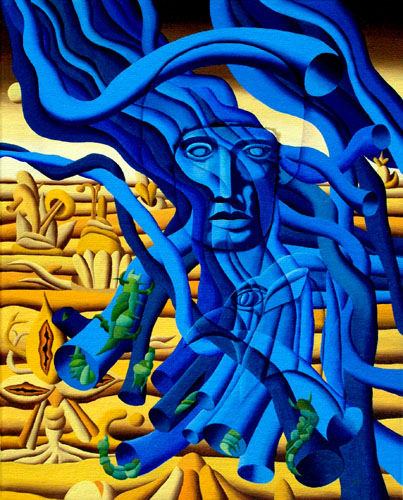
"Antinoos and Hercules" - "Face" - "Apollon" . Oil on canvas, 50 x 40
cm, 1992.
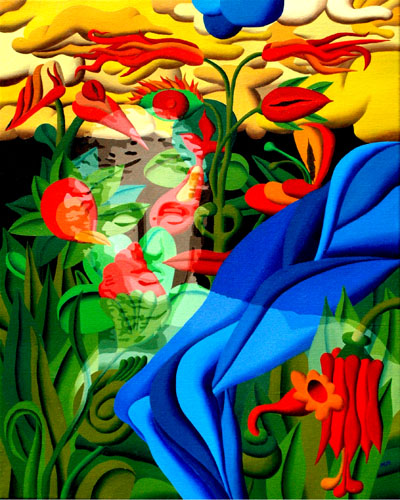

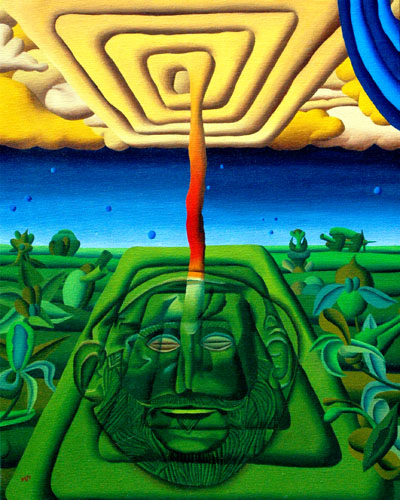
"Knidos - Aphrodite" - "Breast" - "Agamemnon's Death
Mask" - ". Oil on canvas, 50 x 40 cm,
1992.